Abstract
Eight synthetic analogs of the mating pheromone alpha-factor-induced morphogenesis and increased agglutinability in a cells. Most analogs induced increased agglutinability at lower concentrations than those at which they induced morphogenesis, but the ratio of the potencies for the two effects varied 140-fold among different analogs. Morphological response to pheromone required exposure for at least 90 min, but increased agglutinability followed exposures of 20 s. Two synthetic analogs induced neither response. In competition experiments, both of these analogs prevented induction of increased agglutinability and morphogenesis by active alpha factor. The inactive peptides blocked increased agglutinability at lower concentrations than those at which they blocked morphogenesis. alpha factors exhibited different structure-function relationships for morphogenesis as compared with agglutinability. Thus, response of Saccharomyces cerevisiae to alpha factor is complex and may be mediated by more than one receptor.
Full text
PDF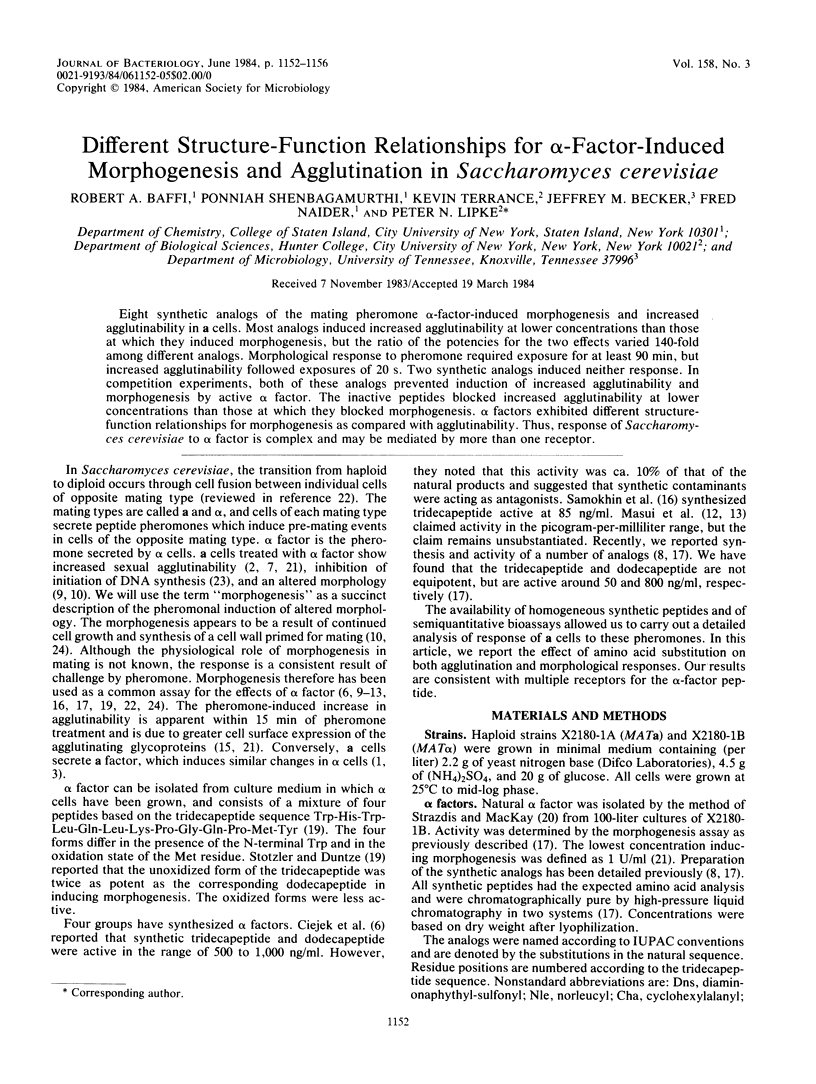
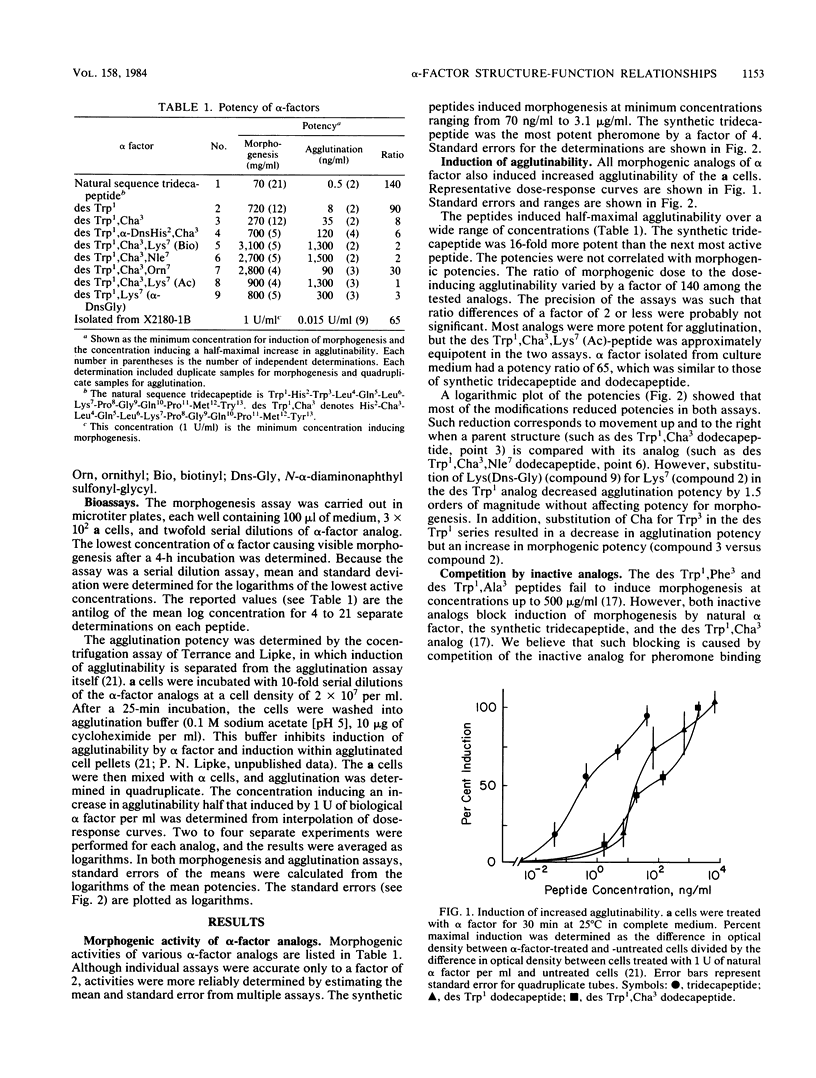
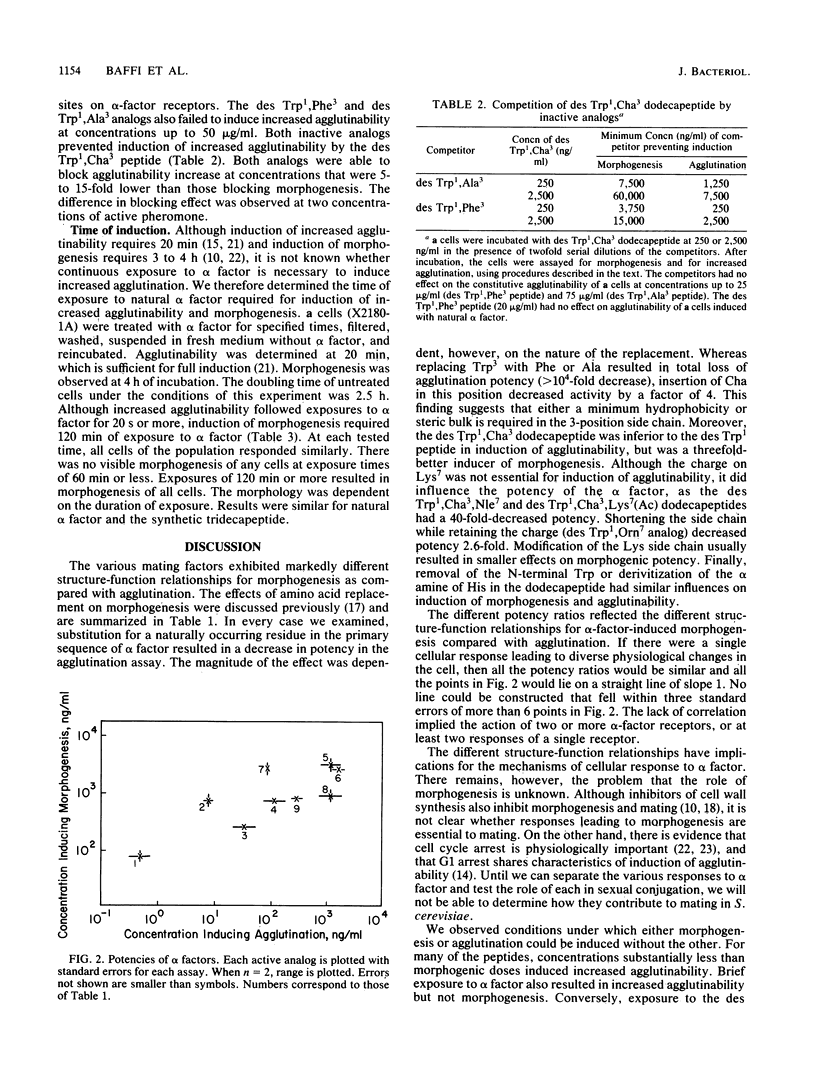
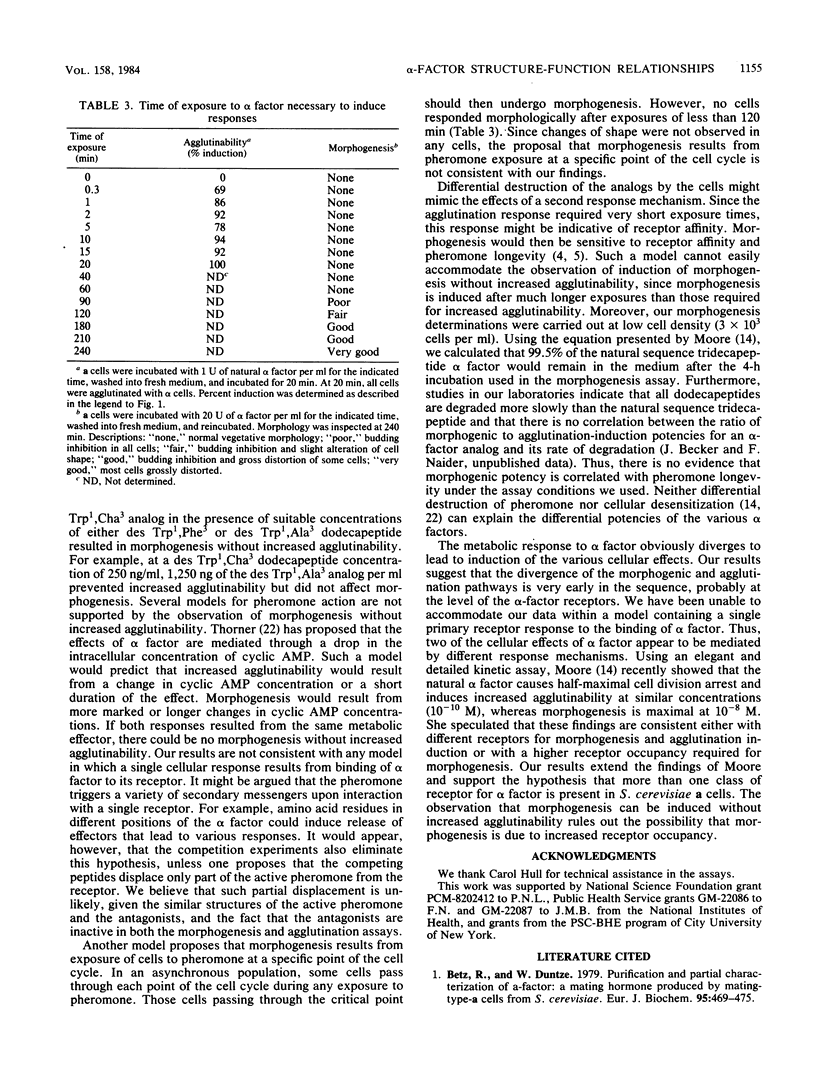
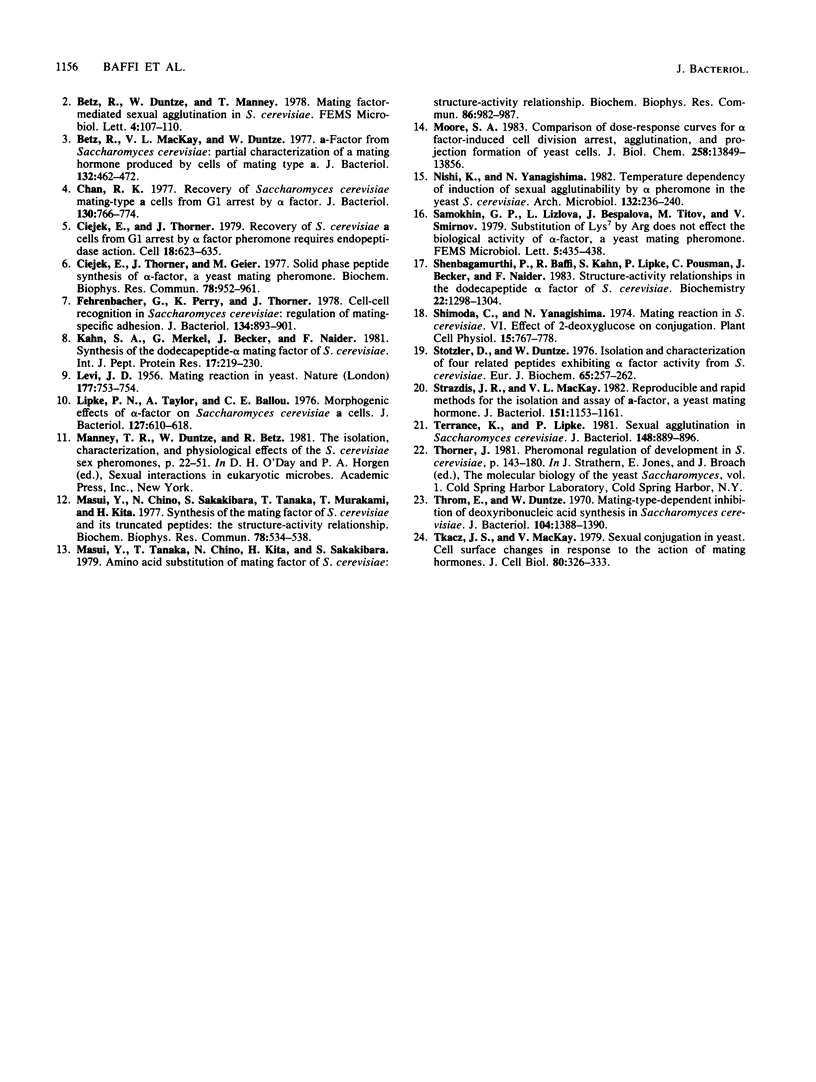
Selected References
These references are in PubMed. This may not be the complete list of references from this article.
- Betz R., Duntze W. Purification and partial characterization of a factor, a mating hormone produced by mating-type-a cells from Saccharomyces cerevisiae. Eur J Biochem. 1979 Apr;95(3):469–475. doi: 10.1111/j.1432-1033.1979.tb12986.x. [DOI] [PubMed] [Google Scholar]
- Betz R., MacKay V. L., Duntze W. a-Factor from Saccharomyces cerevisiae: partial characterization of a mating hormone produced by cells of mating type a. J Bacteriol. 1977 Nov;132(2):462–472. doi: 10.1128/jb.132.2.462-472.1977. [DOI] [PMC free article] [PubMed] [Google Scholar]
- Chan R. K. Recovery of Saccharomyces cerevisiae mating-type a cells from G1 arrest by alpha factor. J Bacteriol. 1977 May;130(2):766–774. doi: 10.1128/jb.130.2.766-774.1977. [DOI] [PMC free article] [PubMed] [Google Scholar]
- Ciejek E., Thorner J., Geier M. Solid phase peptide synthesis of alpha-factor, a yeast mating pheromone. Biochem Biophys Res Commun. 1977 Oct 10;78(3):952–961. doi: 10.1016/0006-291x(77)90514-9. [DOI] [PubMed] [Google Scholar]
- Ciejek E., Thorner J. Recovery of S. cerevisiae a cells from G1 arrest by alpha factor pheromone requires endopeptidase action. Cell. 1979 Nov;18(3):623–635. doi: 10.1016/0092-8674(79)90117-x. [DOI] [PubMed] [Google Scholar]
- Fehrenbacher G., Perry K., Thorner J. Cell-cell recognition in Saccharomyces cerevisiae: regulation of mating-specific adhesion. J Bacteriol. 1978 Jun;134(3):893–901. doi: 10.1128/jb.134.3.893-901.1978. [DOI] [PMC free article] [PubMed] [Google Scholar]
- GLEN W. L., BARBER R., MCCONKEY H. M., GRANT G. A. Isolation of beta-dihydroequilin and alpha-dihydroequilenin from the urine of pregnant mares. Nature. 1956 Apr 21;177(4512):753–753. doi: 10.1038/177753a0. [DOI] [PubMed] [Google Scholar]
- Khan S. A., Merkel G. J., Becker J. M., Naider F. Synthesis of the dodecapeptide-alpha mating factor of Saccharomyces cerevisiae. Int J Pept Protein Res. 1981 Feb;17(2):219–230. doi: 10.1111/j.1399-3011.1981.tb01985.x. [DOI] [PubMed] [Google Scholar]
- Lipke P. N., Taylor A., Ballou C. E. Morphogenic effects of alpha-factor on Saccharomyces cerevisiae a cells. J Bacteriol. 1976 Jul;127(1):610–618. doi: 10.1128/jb.127.1.610-618.1976. [DOI] [PMC free article] [PubMed] [Google Scholar]
- Masui Y., Chino N., Sakakibara S., Tanaka T., Murakami T., Kita H. Synthesis of the mating factor of Saccharomyces cerevisiae and its truncated peptides : the structure-activity relationship. Biochem Biophys Res Commun. 1977 Sep 23;78(2):534–538. doi: 10.1016/0006-291x(77)90211-x. [DOI] [PubMed] [Google Scholar]
- Masui Y., Tanaka T., Chino N., Kita H., Sakakibara S. Amino acid substitution of mating factor of Saccharomyces cerevisiae structure-activity relationship. Biochem Biophys Res Commun. 1979 Feb 28;86(4):982–987. doi: 10.1016/0006-291x(79)90214-6. [DOI] [PubMed] [Google Scholar]
- Moore S. A. Comparison of dose-response curves for alpha factor-induced cell division arrest, agglutination, and projection formation of yeast cells. Implication for the mechanism of alpha factor action. J Biol Chem. 1983 Nov 25;258(22):13849–13856. [PubMed] [Google Scholar]
- Shenbagamurthi P., Baffi R., Khan S. A., Lipke P., Pousman C., Becker J. M., Naider F. Structure-activity relationships in the dodecapeptide alpha factor of Saccharomyces cerevisiae. Biochemistry. 1983 Mar 1;22(5):1298–1304. doi: 10.1021/bi00274a047. [DOI] [PubMed] [Google Scholar]
- Strazdis J. R., MacKay V. L. Reproducible and rapid methods for the isolation and assay of a-factor, a yeast mating hormone. J Bacteriol. 1982 Sep;151(3):1153–1161. doi: 10.1128/jb.151.3.1153-1161.1982. [DOI] [PMC free article] [PubMed] [Google Scholar]
- Stötzler D., Duntze W. Isolation and characterization of four related peptides exhibiting alpha factor activity from Saccharomyces cerevisiae. Eur J Biochem. 1976 May 17;65(1):257–262. doi: 10.1111/j.1432-1033.1976.tb10412.x. [DOI] [PubMed] [Google Scholar]
- Terrance K., Lipke P. N. Sexual agglutination in Saccharomyces cerevisiae. J Bacteriol. 1981 Dec;148(3):889–896. doi: 10.1128/jb.148.3.889-896.1981. [DOI] [PMC free article] [PubMed] [Google Scholar]
- Throm E., Duntze W. Mating-Type-Dependent Inhibition of Deoxyribonucleic Acid Synthesis in Saccharomyces cerevisiae. J Bacteriol. 1970 Dec;104(3):1388–1390. doi: 10.1128/jb.104.3.1388-1390.1970. [DOI] [PMC free article] [PubMed] [Google Scholar]
- Tkacz J. S., MacKay V. L. Sexual conjugation in yeast. Cell surface changes in response to the action of mating hormones. J Cell Biol. 1979 Feb;80(2):326–333. doi: 10.1083/jcb.80.2.326. [DOI] [PMC free article] [PubMed] [Google Scholar]


